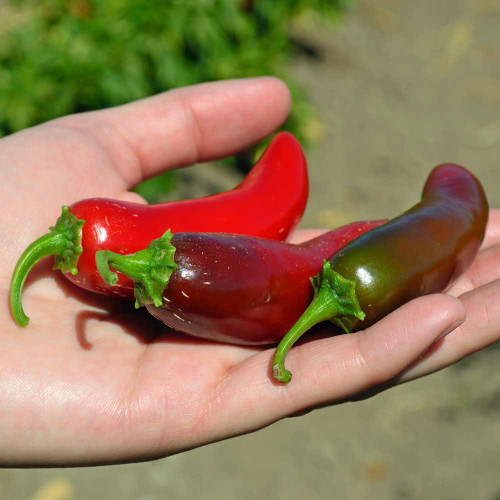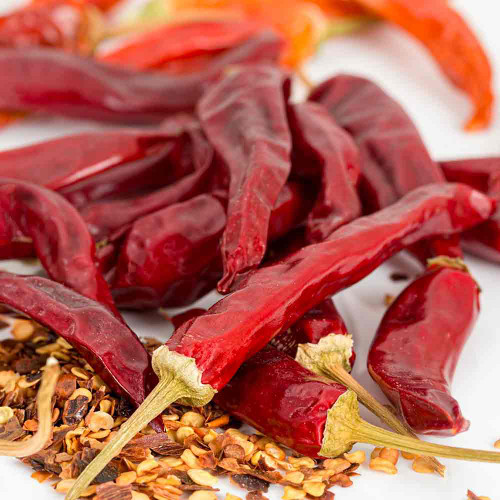Description
Beaver Dam Pepper - A Community Heirloom
In the fall of 2005, Mayo Underwood — founder of Underwood Gardens — received the original pepper seed stock for this distinctive Hungarian heirloom pepper from the Hussli family, grew it out, and offered it in limited quantities in 2006. It’s been a mainstay ever since.
The Beaver Dam Pepper emphasizes quality over quantity, producing fewer but larger peppers per plant that never fail to impress with their size and flavor. It needs a little more attention and care but rewards you with abundant flavors.
Once tasted, home gardeners invariably plant more next year — five to ten plants are common for those loving the crunchy, rich, and fruity flavors that follow the first sweet taste.
Seed conservationists consider the Beaver Dam Pepper “a community heirloom” because it’s grown beyond the family who brought it to the United States. Cousins of Larry, who live in the Phoenix, AZ area, contacted us a few years ago when they learned we carried Joe’s pepper, thanking us for continuing the work he started so long ago.
Details
“There’s heat in the back, but the first thing you taste is a sweet chile flavor,” said one of our growers.
The Beaver Dam chile pepper introduces itself with a pronounced crunch immediately followed by a slightly sweet flavor mixed with a mild to moderate heat that slowly builds but doesn’t overpower its other flavors.
Mature pods always catch eyes and attention — these large and impressively heavy peppers have broad shoulders up to 3” wide, ranging from 6 - 9” long and tapering to a blunt point. The skin is shiny, smooth, and taut, maturing from a bright lime green when young to an eye-catching deep lipstick red. The flesh is thicker than expected, crisp, and crunchy when raw, retaining a good texture and excellent flavor when cooked. You can easily remove the large ribs and attached seeds to keep the heat level low.
Once you grow it, you’ll understand why many home gardeners and cooks consider it the quintessential Eastern European stuffing pepper.
Easy to grow, each plant usually produces between three and eight peppers, starting with a single fruit at the beginning of the season and ending with four or five maturing at the end. Plants need staking, trellising, or a cage to support the weight of the peppers so they don’t fall over. Consistent soil moisture and steady sunshine give the best growth and flavor, as with most peppers. Provide afternoon shade in hotter climates to keep production high and heat levels low.
The first fruits are ready for harvesting at the lime green stage about 80 days from transplanting and will typically finish to their characteristic brilliant red a couple of weeks before the first frost.
History
The story of this treasured pepper is both familiar and poignant — seeking a new life away from increasing strife and uncertainty, only the most essential and valued items packed into a couple of suitcases, with the most precious stitched into hems or inside pockets to keep them safe.
One of those choices was seed — only able to bring, at most, a couple of vegetables that nourished the family over generations, keeping those cherished memories alive in a new country. These seeds were so valuable that they could not imagine a new life without them, so they were carefully tucked away, checked, and guarded over the long journey until they finally arrived at their new home.
Then, it was grown, enjoyed, and shared in their new community until it became the pepper of the area. As kids and grandkids married and moved away, seeds were gifted to grow in new locations and homes, creating new traditions, dishes, and memories.
We know of at least two families that recognized the value of this outstanding pepper and brought seeds from the area around Apatin, which was Hungary at the beginning of the 20th century but is now the border area between northeast Serbia and western Croatia.
Joe Hussli is credited with bringing the first pepper seeds to the little community of Beaver Dam in 1912, with the young teenager Anna Csiacsek bringing additional seeds nine years later, in 1921, when she traveled alone to join her parents.
Joe was German-Hungarian — he grew up in Germany and later moved to Hungary. While he was in the army, he worked under a general who told him war was inevitable as European tensions rose. In 1912, Joe moved to America, bringing seeds of the pepper his family had eaten for generations. Once in Beaver Dam, he shared seeds and plants with his neighbors, establishing what would become the Beaver Dam Pepper.
Anna was 15 years old when she came to Beaver Dam with pepper seeds sewn into the hem of her dress in 1921, joining her mother and father, who had come over earlier. Anna’s father arrived in the early 1900s and saved money to bring his wife over. Together, her parents saved to bring Anna over after the war ended. The peppers were one of Anna’s favorite ingredients to cook with, and she taught her children and grandchildren how to grow, harvest, and save seeds of what would become known as the Beaver Dam Pepper.
From there, seeds traveled with successive generations as they married and moved away, bringing a taste of home and generational memories to new lives.
Uses
Anna’s favorite pepper recipe was Hungarian potato goulash, a recipe she also brought over with her that’s been passed down in the family. Her version is more broth than thick stew. Tim Csiacsek says his grandmother would put a tablespoon of white vinegar into each serving bowl for extra flavor and thick, homemade noodles before ladling the goulash.
Beaver Dam peppers are delectable raw and cooked, whether baked, roasted, grilled, or stir-fried. Chopped raw peppers add flavor to pasta, pizza, soups, stews, and sandwiches, or can be tossed into salads. Cooking deepens the flavors of hot sauces, salsas, marinades, added to jellies, or pickled. Roasting or grilling mellows out the heat, whether whole or stuffed with meats, cheeses, and rice.
Companion Planting
Planting basil among peppers repels fruit flies, thrips, and several beetle species that feed on the fruit. Basil’s aroma masks the volatile chemicals or scent from pepper (and tomato) plants. Alliums — onions, leeks, garlic, chives, scallions, and shallots — deter aphids and beetles. The scent of the alliums helps mask the scent of the pepper plants, making it harder for the pests to find them.
Plant crimson clover as a living mulch between your pepper plants and their companion plants — leaving no bare soil. This approach reduces weeds, as they are out-competed for light, moisture, and nutrients, feeds nitrogen to the nearby plants, and the blossoms feed beneficial insects and pollinators. Make sure to cut the clover down to the soil level when the first blossoms begin dying to avoid setting seeds for the next season. The stems and leaves will act as a mulch and feed the soil as they decompose.
Planting Tip
Pepper seeds are sensitive to soil temperature and can take 2-4 weeks to germinate. The optimal soil temperature is 80-85°F, and even 5°F below that can delay germination by 2 or 3 weeks. Use a heat mat, heating pad, and thermometer to maintain even soil temperature. Chile seeds don’t need light to germinate but thrive with a strong light source once the sprouts appear. If you see the seedlings stretching or becoming leggy, they need more light.
Soil moisture should be damp when sprouting, then slightly moist once the seedlings are up. Damp soil will leave a slight wet spot on the pad of your finger when touching the soil’s surface. You will feel the moisture but not see a wet spot with slightly moist soil. Avoid over-watering the seedlings to minimize damping off — a fungal disease and fungal gnats attracted to damp soil.
Harden off the seedlings one to two weeks before transplanting time by setting them outside in a sunny, protected area for a half hour for the first few days, then gradually increasing the outside time until they are outside full-time for transplanting.
Growing Tip
Transplant Beaver Dam seedlings when the last frost date has passed, preferably one to two weeks after, to avoid a late-season cold snap. Young plants are tender, and one cold snap can set growth and production back for the rest of the season.
Give the young seedlings about 18” of room to grow — this allows room for a trellis, stake, or cage once they are full size. You can trellis them after transplanting or when they start setting buds but before the flowers open.
For the best flavor and production with the least heat, peppers thrive with consistent soil moisture levels in the top foot of the soil — this is where 90% of the plant’s roots are. You can test the soil moisture by inserting your index finger fully into the soil — you should easily feel that the soil is moist, but your finger shouldn’t be wet when you remove it.
Watch the youngest plant leaves — at the top — to know when to water. When the leaves begin wilting is the prime time to water. With hot, dry conditions, fast-growing plants will wilt in the late afternoon. Drip irrigation with a timer is an excellent way to avoid over or under-watering your pepper plants.
At the end of the season, gradually decreasing the irrigation frequency and amount helps the plants finish ripening and deepen the color of the last pods.
Harvest Tip
In Beaver Dam, usually starting around the first of August, the peppers are picked when they are close to red, and harvest continues until just before the first frost.
Once the peppers are past the light lime-green stage, they are ready for the first harvest. Squeeze the pepper pod to feel if it is ready — it should feel firm, the skin should be tight and shiny, and the pepper should feel meaty and heavy.
Clip or cut the stem from the plant, taking care not to damage the pod or the plant. Pulling or breaking the stem will leave a ragged wound for the plant, inviting diseases.
Learn More
- Growing Peppers 101
- Chile and Pepper Growing Tips
- Grow Better Peppers with Shade
- Fermented Pepper Sauce
- Fermented Chile Paste
This unique variety is on Slow Food USA Ark of Taste. The Ark is an international catalog of foods that are threatened by industrial standardization, the regulations of large-scale distribution and environmental damage. In an effort to cultivate consumer demand—key to agricultural conservation—only the best tasting endangered foods make it onto the Ark.

From the soil to the seed to the food you eat - we'll help you grow your best garden!
4 Reviews
-
Prolific production, very impressive fruit
Started on March 11, transplanted April 30 with excellent germination and strong seedlings. Plants grew up to 3 feet in height, were very healthy, heavily leafed and branched providing good shade for the developing fruit. Picking began July 2 through early October. Production was prolific, a very impressive fruit turning from pale green to a deep red. We did not find the peppers extremely hot, nor did we have problems with touching them and causing skin irritation as was noted in some other reviews. A very good variety for this area.
-
Still smokin!
This pepper is HOT!! I grew it in honor of a friend who is an M.D. in Beaver Dam, and was surprised that they burned my skin on my hand when I removed the seeds/insides. Be forewarned, if you can't take things too hot. Beautiful color and a strong grower. They haven't yet turned red here in Illinois.
-
Hot, but Good
I grew up in Beaver Dam and know some of the Hussli family. When I saw this at a local nursery, I had to have it. I have used it in chili and in salsa. They are big, meaty and Hot. When preparing the, wear rubber gloves, or your skin will burn for several hours, no matter how much you wash them.
-
Big and hot
I grew these last year in a very hot dry summer. They were a fantastic pepper in the garden. A bit slow to grow, and few flowers at a time on the plant, but were they ever tasty. I picked them yellow, and they ended up being a favorite to share with the neighbors. I suggest planting a few more plants than usual if you are expecting a hot dry summer, to get a large crop.















